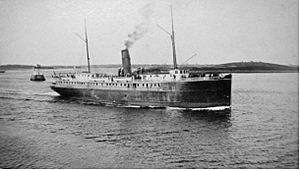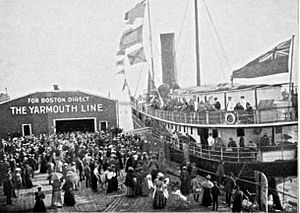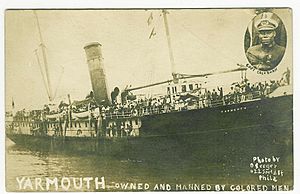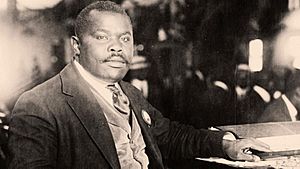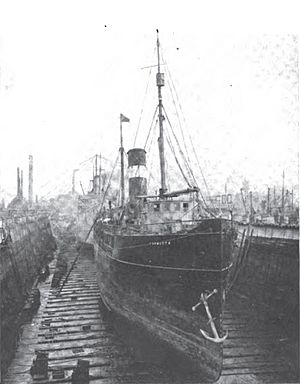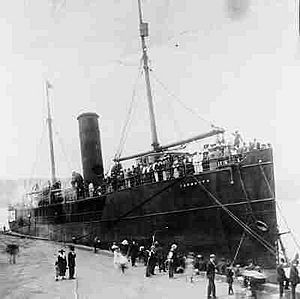SS Yarmouth facts for kids
The SS Yarmouth was a special steamship that helped connect Yarmouth, Nova Scotia, Canada, with Boston, Massachusetts, in the United States. Later, it became the most important ship (called the flagship) for the Black Star Line. This shipping company was started by Marcus Garvey, a famous leader who wanted to help black people around the world. His ideas were very strong and important, and they still influence people today. The Black Star Line's name was a nod to the famous White Star Line, and its memory lives on in the flag of Ghana.
Contents
Building the Yarmouth
The Yarmouth was built in Dumbarton, Scotland, by a company called Archibald McMillan & Son. It was made for the Yarmouth Steamship Company in Nova Scotia, Canada. The ship was designed to carry both people and goods.
It was a strong ship made of steel, about 220 feet (67 m) long and 35-foot (11 m) wide. It could travel at a speed of 14 knots (which is about 16 miles per hour). The ship's bell was made in Philadelphia, USA.
The Yarmouth was launched on February 28, 1887. It was meant to be the best ship on the route between Eastern Canada and the United States. It took only 9 and a half days for the ship to cross the Atlantic Ocean on its first big trip. On May 3, 1887, it arrived in Yarmouth. A few days later, on May 7, it made its first trip to Boston with Captain Harvey Doane in charge.
The Yarmouth continued to sail on the Yarmouth – Boston route until 1911.
The Yarmouth Steamship Company
In 1885, a businessman named L.E. Baker wanted to grow his businesses in Nova Scotia. He saw that there was a need for good ways to travel between Yarmouth, other ports in the Bay of Fundy, and Boston. Baker believed that a shipping company would bring tourists to Nova Scotia. It would also create chances to build hotels and train connections along the ship's route.
Baker started by buying a ship called the SS City of Saint John in November 1884 with Captain Harvey Doane. Soon after, in May 1885, he created the Yarmouth Line. This company bought a dock and another ship, the SS Dominion. These ships regularly traveled on important routes for travel and trade, like Yarmouth to Boston, and Halifax to St. John.
In 1886, Baker bought another ship, the SS Alpha. With these ships, the company could offer trips for passengers and cargo from Yarmouth to Halifax, Boston, and Saint John. To get more money, Baker changed the company's name to the Boston & Yarmouth Steamship Company in February 1887. This helped them buy the SS Yarmouth for the Boston route, which started in May 1887. Business was good, and they added another ship, the SS Boston, in September 1890.
In 1894, Baker's shipping company joined with his railway company to become part of the Dominion Atlantic Railway. Baker passed away in 1899.
In 1911, the Canadian Pacific Railway (CPR) took over the Dominion Atlantic Railway (DAR) company. The DAR then sold three ships and all its rights to the Boston route to another company called Eastern Steamship. Because of this, the CPR moved the Yarmouth to a new route between Digby and Saint John, New Brunswick.
The Yarmouth in World War I
In 1916, the CPR replaced the Yarmouth on its Digby – Saint John route and sold it to the North American Steamship Company (NASC). From then on, the Yarmouth mostly carried coal between Nova Scotia and Boston. The owner of NASC, W. L. Harriss, bought the Yarmouth for a lot of money. He made his money back by using the ship several times to carry goods across the Atlantic Ocean during the war. He was very eager to sell the ship to a new owner.
The Black Star Line
On September 17, 1919, the Yarmouth was bought by the Black Star Line (BSL). This company had just started in June 1919. The BSL was founded by Marcus Garvey, a leader who believed in Black nationalism. One of his main goals was to help black Americans and Jamaicans move back to Africa, possibly to create a black-led nation there. He started the Black Star Line by selling shares (parts of the company) for $5 each to members of his United Negro Improvement Association (UNIA). The name Black Star Line was chosen to sound like the famous White Star Line, which owned the Titanic.
Garvey wanted to have an all-black crew for his ships. He found a skilled black captain, which was rare at the time. This captain was Joshua Cockburn, who was born in Nassau in the Bahamas. Captain Cockburn had worked for other shipping lines and had a lot of experience sailing between Britain and West Africa. Garvey said that Cockburn was the first black man to command a ship on deep-sea voyages. Cockburn was paid well and Garvey trusted him completely. One of Cockburn's first jobs was to find a good ship and arrange its purchase.
The Black Star Line and Garvey's other projects were being watched by agents from the Bureau of Investigation (FBI). One of these agents, Dr. Arthur Ullysses Craig, went with Captain Cockburn to inspect the Yarmouth. Craig was the first black electrical engineer in the USA and was very qualified.
The ship needed a lot of big repairs. Its boilers needed fixing, and its hull (the main body of the ship) was very old. Even though Craig advised against it, Cockburn thought the ship was still safe to sail. Soon after, the BSL had to find $5,000 to fix the boiler before the ship's first trip.
The seller of the ship was very keen to sell, and Cockburn and his friends were earning money from the sale. So, the seller didn't pay much attention to the Black Star Line's lack of experience or its money problems, which had stopped Garvey from buying ships before.
To get around the Black Star Line's money issues, the Yarmouth was basically rented by Black Star Incorporated. They were supposed to pay for it in 10 monthly payments, totaling $165,000, before they would fully own it. However, the Black Star Line couldn't pay the full first payment, so the agreement was changed to a monthly rent of $2,000.
The creation of the Black Star Line and all its activities were important political statements. Garvey's newspaper, the Negro World, often talked about how important the line was. The Yarmouth was unofficially renamed the Frederick Douglass, but this change was never officially completed in the ship's papers. So, it remained registered as the Yarmouth. Even though the Black Star Line claimed to own the ship, they actually only leased it. Because the full payments were never made, the ship sailed under British registration and the Union Jack and Maple Leaf flag during its time with the Black Star Line.
Its first big trip for the Black Star Line was to the West Indies and Central America on November 24, 1919. Most of its crew were black British, except for one Scottish engineer.
The ship's first short trip for the new line was on October 31, 1919. It left the dock near Garvey's office with a big celebration from thousands of people. Garvey was already having money problems, and it was hard to get insurance for the ship. This short trip needed special permission from the ship's original owners.
The second trip on November 24, 1919, was to Sagua la Grande, Cuba, carrying cement. When it arrived in Cuba on December 5, Captain Cockburn complained to Garvey that the white officers were causing trouble. However, the ship was welcomed warmly in the port, and local workers even bought shares in the company. The ship then sailed to Jamaica and Panama, but there was no new cargo to pick up. On its way back from Cuba, it had many passengers and a full cargo, but it faced repair problems and arguments among the officers and crew about wages. It returned in January 1920.
The third trip, soon after Prohibition (when alcohol was illegal in the US) began, was to deliver whiskey from a distillery to Cuba. The ship was loaded very quickly because the Prohibition law was going to start the next day.
Garvey wrote that he had to spend $11,000 on repairs for the ship to sail with a cargo worth millions of dollars. He said this was because two officers of the company were disobedient. The deal to carry the whiskey was very cheap for the distillery, only 10 percent of what other shipping companies would charge.
The ship left New York on January 17 in a hurry. Near Cape May, the cargo shifted, and the ship began to tilt badly. Two days later, it was reported that the ship was sailing strangely, slowly sinking, and the crew was acting oddly.
The United States Coast Guard said the ship needed to be towed home. A company with a salvage tug (a boat that helps rescue other boats) arrived, but the Yarmouth managed to return to port on its own power. This saved the company from having to pay a large rescue fee. Some people claimed that the captain had stopped a plan to hijack the ship and that an engineer had tried to sink it by opening a valve. One story says that Captain Cockburn himself ordered 500 cases of whiskey and champagne to be thrown overboard to make the ship lighter. Small boats "suspiciously" nearby quickly picked up the goods.
Some of the valuable cargo was lost because the crew and repair workers stole bottles. This led to government agents temporarily taking control of the cargo. Garvey said that the whiskey belonged to "Southern Crackers" (a term for white people from the Southern US). In the end, the Black Star Line paid more in damages to the distillery than it earned from carrying the cargo.
After very expensive temporary repairs, the Yarmouth sailed again. These repairs were done at the Morse Dry Dock and Repair Company in Brooklyn, which had the largest floating dry dock in the world.
When the Yarmouth arrived in Cuba, a local newspaper reported that it was called the "Ark of the Covenant of the colored people and a bright sign of better days."
In April 1920, the Black Star Line bought its second ship, the Shady Side, and in early May 1920, they bought a yacht called the Kanawha.
What Happened to the Yarmouth
When it returned in May 1920, the Yarmouth hit the ground near Boston. It made its last voyage under a new captain to the West Indies. Then, in the fall of 1920, while anchored in New York, it was in a collision and started to sink. It was towed to a dock for repairs.
Meanwhile, the Black Star Line had to delay payments. Their income was much less than their operating costs. In November 1921, a court ordered the ship to be sold at a public auction for $1,625. The Black Star Line tried to appeal this decision, but the case was dropped because they didn't pursue it. By then, the Black Star Line was out of business.
The Yarmouth was taken apart for scrap metal by the Pottsdown Steel Co. of Philadelphia.
During its time, the Black Star Line visited ports in Costa Rica, Cuba, Jamaica, Panama, and other countries. However, it never managed to reach Africa.
The Mail Fraud Case
The Black Star Line faced many problems, and Marcus Garvey's leadership was questioned when issues with his business dealings led to charges of mail fraud. Investigations by the FBI led to a trial in New York City, which began on May 18, 1923. This trial provided many details for future historians. For example, the actual value of the Yarmouth when it was bought in 1919 was discussed. One of its officers said that since the ship had been used to carry coal, it was "not worth a penny above $25,000." The prosecution argued that because it had been used to carry cattle, it was not suitable for passengers.


